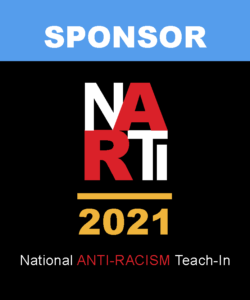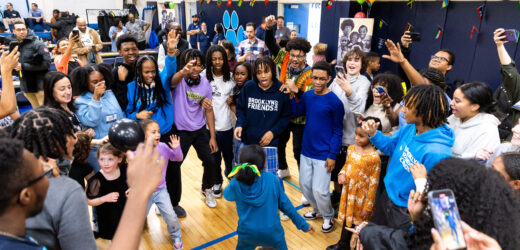Office of Diversity, Equity and Belonging
What Does Diversity Look Like at BFS?
From curating a whole day of professional development to partnership with divisional leaders to thought sharing with colleagues, these invitations legitimized the purpose of Brooklyn Friends’ DEB office and makes visible the integrity of this community’s commitment. Values of equity, community, wholeness, imagination, learning and justice enacted in authentic ways through the collective responsibility we all hold in our hands.
In the spirit of centering all the ways we do the work, here are some snapshots from divisional life which illustrate the ways souls, humanity, character, and criticality are nurtured in our school—not necessarily as guided through the DEB office—but as a collective experience; work that is the heart of the Brooklyn Friends School mission and takes us from where we have always been in ways that are grounded in the “now” of our world for learning that is timely and enduring.
Preschool
The foundational learning for Preschool was developing community and friendship which incorporates the NAEYC anti bias goals. Query: How are we the same and different and how do we celebrate each other and learn what is fair? Evidence of this is embedded in the curriculum, particularly in the choice of books and ongoing team reflection. Activity: AntiBias Principles in Early Childhood, Identity exploration, representation and conversations about family and what kindness truly means.
Lower School
In the Lower School, Kindergarten Head Teacher, Laleña Garcia, and Associate Teacher, Olivia Sweet, engaged in an activity at morning meeting reflecting on the meaning of Collective Value. “The goal was to show that everybody is important and has the right to be safe and happy, no matter what religion they are, how much money they have, where they come from, their abilities or disabilities, or who they love. “Just like in our community, everyone has to be safe!” one child exclaimed. Children then took some time to think about things that are important to their KC community and work collaboratively on posters demonstrating the values as a community. As noted in class news, many children were moved to write words, as well as draw pictures, demonstrating their growing understanding of the power of words. After the activity was completed, the children looked at them together to share what they noticed, and discuss why they chose the images and words they did.”
Middle School
The Middle School’s Affinity Club Program included G.A.Y.E.S.T. LGBTQIA+ and IMANI for Black and Brown Girls of Color, were spaces for affirmation and identity development of youth. Connection, community, voice, justice, and awareness building transpired. As one student named: “We found each other, and that feels good.” Marching in Brooklyn Pride, an activism act, was the culmination of the school year!
Upper School
For Spanish language learning in the Upper School, there were activities in amplifying a “single story” of a chapter of Dominican History and Culture. By inviting partnership in planning, Vanessa incorporated narrative and interview with Dominicans introducing counter-narratives and personal stories to impact the singular story of the Trujillo era.
How are Equity & Belonging Approached at Brooklyn Friends School?
The Office of Diversity, Equity, and Belonging explores various aspects of diversity through three different lenses: Comprehensive, Intersectional, and Power & Privilege.
- Comprehensive- Critical analysis of the various aspects of diversity and the way in which it impacts us as individuals as well as interpersonally.
- Intersectional – is a concept often used (in critical theories) to describe the ways in which oppressive institutions (racism, sexism, homophobia, transphobia, ableism, xenophobia, classism, etc.) are interconnected and cannot be examined separately from one another.
- Power & Privilege: Privilege is defined as benefits and resources gained by any person(s) or groups of people who have access to a larger dominant culture within a society due to any one of their social identifiers. Power is defined as the possession of control or command over others; exercising authority or being able to impact/influence a perceived reality or external environment.
BFS is One of the Most Diverse Independent Schools in New York
Diversity is a core value of Brooklyn Friends School, and we are actively committed to building and maintaining a racially, ethnically, and socio-economically diverse community. We know a multicultural school community creates an enriched learning environment through the exploration, understanding, and appreciation of differences. It prepares students for living in an increasingly diverse and global society.

Brooklyn Friends School is committed to maintaining an environment in which all people are respected and valued. To that end, discrimination in any form, such as that based on race, religion, ethnicity, gender, gender identity, sexual orientation, or socio-economic status, will not be tolerated. The School actively strives to recognize, respect, and celebrate the differences and commonalities that shape the individual and collective identities of its members.

Brooklyn Friends is proud to partner as a Gold Sponsor and send 16 community members to the 2021 National Anti-Racism Teach-In.
History of Diversity at BFS
Grounded in our Quaker values, diversity is a core value of Brooklyn Friends School. As articulated in the 2008 Strategic Plan, a multicultural school community creates an enriched learning environment through the exploration, understanding and appreciation of differences. It prepares students for living in an increasingly diverse and global society.
The Office of Equity and Inclusion has been in existence for six years. Prior to July 2011, there were various individuals within the BFS community who were actively involved in diversity related work and helped to lay the foundation. BFS recognized the importance of this work, the way in which it falls in line with the mission of the school and the Quaker commitment to social justice. Members of the school community worked together to actualize the vision for the creation of the office. This office has been instrumental in building off of the foundation that had been laid by individuals by giving the previous efforts shape, language and direction.
Affinity Groups at Brooklyn Friends School
What is an Affinity Group?
An Affinity Group is a group of people who share a similar identity. Although members of the group may have a common identity, it does not mean that everyone in the group has had the same experiences. Rather, the group is a place for reflection, dialogue, and support; it ultimately strengthens ties within the community. Facilitating positive identity exploration is central to creating an inclusive and thriving community.
Why do we have affinity groups at BFS?
We want to create open spaces where members of the Brooklyn Friends community can explore ideas about identity, share resources, mentor each other, learn, and grow. Affinity Groups are one way that we can support one another and are active in the Lower through Upper Schools, as well as among Faculty/Staff schoolwide.
Which Affinity Groups are offered to students?
- Faith/Religion Based groups:
- Atheist & Agnostic
- Christian
- Jewish
- More Religions at BFS (Buddhist, Muslim, Spiritual, etc)
- Family Structure (Adopted, Divorced/Separated, Deceased, LGBTQ+, Mental Illness)
- LGBTQ (Lesbian, Gay, Bisexual, Trans/Gender Non-Conforming, Questioning)
- Learning Differences
- Race/Ethnicity Based Groups:
- Biracial/Multiracial Students
- Middle Eastern/Arab
- African, Black/African-American, Caribbean-American
- Asian, East Asian, Pacific Islander
- Hispanic, Latino/a
- First Nation/Indigenous/Native American
- White Students for Anti-Racism
- International (1st or 2nd generation)
Which Affinity Groups are offered to faculty and staff?
Intersections, Jewish Affinity Group, Latin@/Hispanic Group, LGBTQ, MARSH Group (Men Against Racism Sexism and Homophobia), People of Color Group and the White Affinity Group.
What is Identity?
There are lots of layers to who we are and many different ways we may choose to identify or are identified by society. Identifiers include gender, race, ethnicity, nationality, religion or nonreligion, language, and sexual orientation, to name a few. Some identifiers are defined externally to us, by history, society, our family, etc. Others are internal choices that we make.
The way we identify may differ from how others see us and may change over time. Just because we share an identity with another person does not mean we experience it in the same way.
Resources about Diversity
General
How to Be an Ally if You Are a Person with Privilege
Why Positive Stereotypes are More Harmful than They Seem
What White Children Need to Know About Race (Affinity Groups)
Making Space (Affinity Groups)
Identity, Affinity, Reality (Affinity Groups)
Don’t Believe in Christian Privilege? These 15 Examples Will Leave No Doubt
Illustration: Microaggressions in the Classroom
Ability
Socio-Economic Class
Gender and Sexuality
Taking Steps to Support Transgender Students and School Communities
Before it was Legal: Vintage Pics of Black Gay Couples Through Time
Homophobia has robbed all men of touch
Sexuality and Gender Activism: Gender-Neutral Pronouns
She? Ze? They? What’s In a Gender Pronoun
13 Questions That Cis Men Never Have To Ask Themselves
Sasheer Zamata Says Women’s Rights Still a Big Deal
48 Things Women Hear In A Lifetime (That Men Just Don’t)
48 Things Men Hear In A Lifetime (That Are Bad For Everyone)




